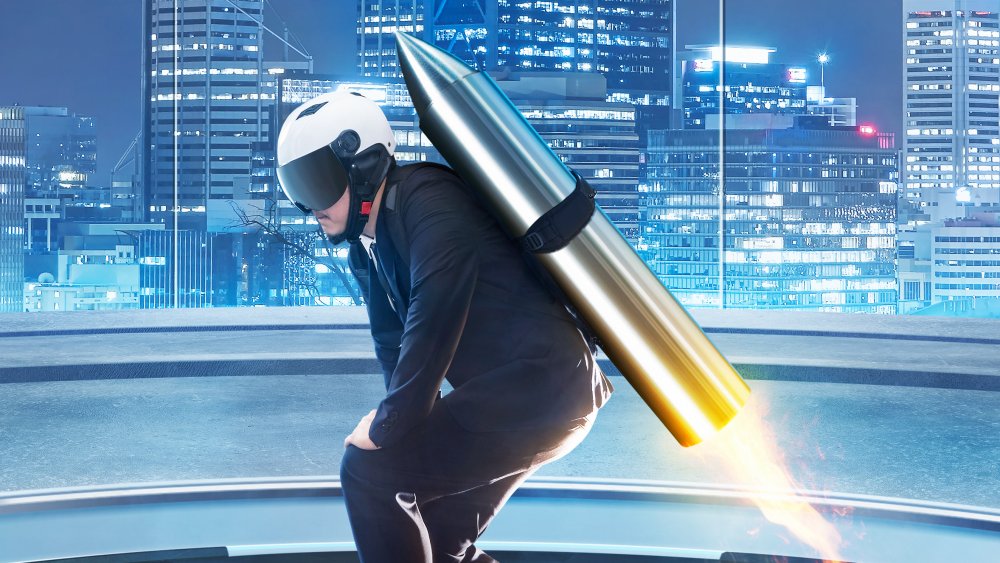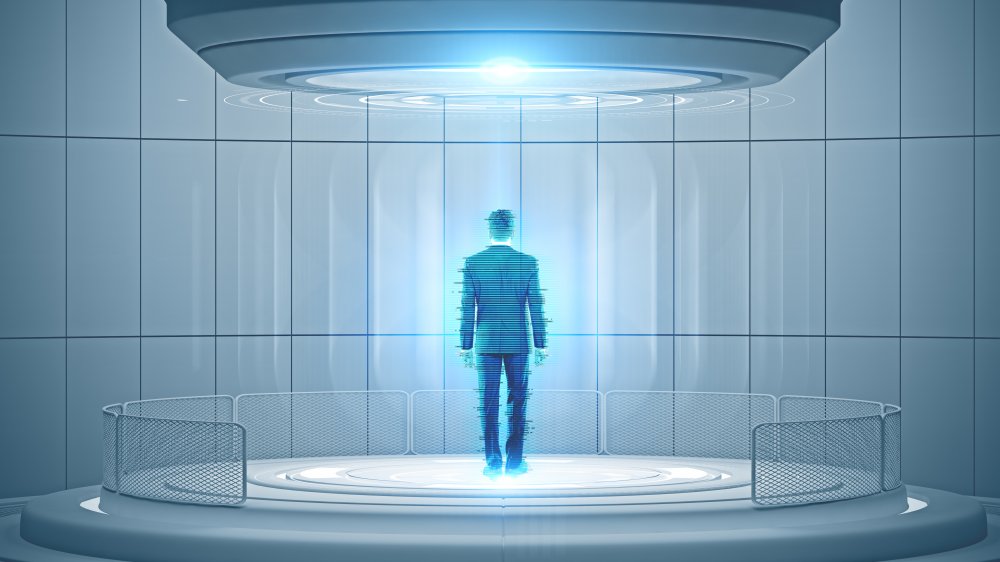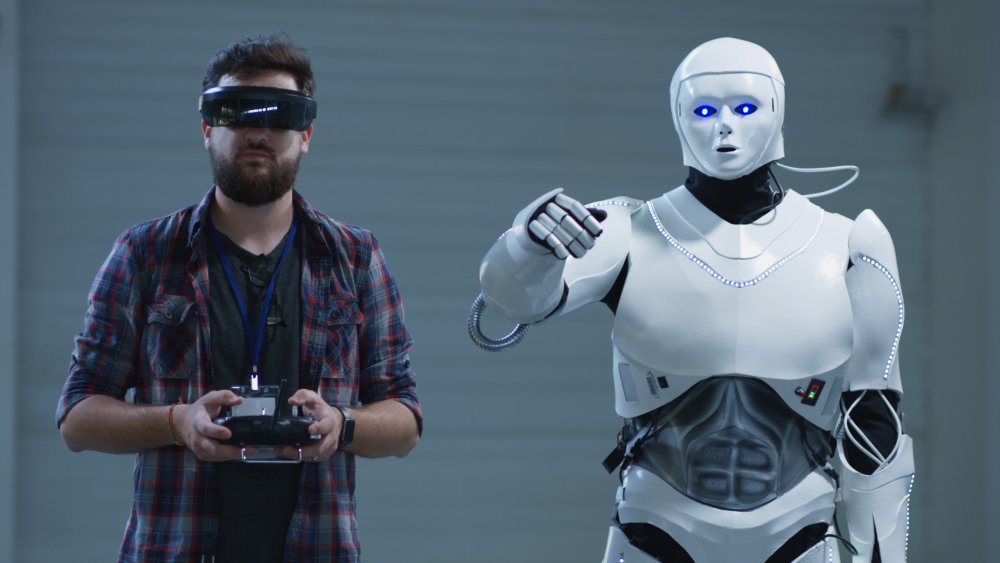Awesome Sci-Fi Movie Technology That Would Be Terrifying In Real Life
Ever since science fiction became a genre, writers have envisioned the future of technology in all kinds of beautiful, zany, and/or terrifying ways. Over the past century, gadgets and gizmos that once seemed preposterous have become everyday items. Whether you're reading about the history of ancient China on that little pocket computer you call a "phone," Skyping with your friend in France, or shouting orders to your Amazon Echo from afar, your life is now a 1950s sci-fi flick.
However, not every wacky science fiction technology has made its way to the real world ... and sometimes, that's for the best. While some of the crazy technology in the movies might look wondrously convenient, the application of such technology in real life — with real science — can have devastating consequences. Don't believe it? Here's why some of your favorite science fiction devices would be unfathomably frightening if you had them at home.
Teleporters? More like death machines
C'mon, be honest. How many times have you waded through TSA nonsense at the airport, when — perhaps somewhere between taking out your laptop and removing your shoes — you've wished that some crack team of MIT students would make those nifty transporters from Star Trek into a real-world technology?
Unfortunately, if real transporters existed, you might want to pause before stepping inside. Why? Because, as Star Trek technical consultant Michael Okuda points out, these so-called "teleportation devices" work like three-dimensional televisions: essentially, they convert a person's atoms into energy, and relocate that energy to another place. Basically, it de-atomizes your entire body where it stands on, say, Romulus, then recreates that body on the bridge of the Enterprise. The problem, as as Gizmodo points out, is that while the Enterprise version of "you" might look, act, and have the memories of the original, it's technically just an identical copy ... or a clone, if you prefer that. Oops. Now, you can debate whether your "essence" legitimately transfers to the reassembled body, and your feelings on this probably are closely linked to your beliefs regarding souls. Ask yourself, though: if there was the slightest chance that teleportation would kill and replace you, would you let Scotty beam you up?
Keep in mind, even on Star Trek, this stuff doesn't always work out perfectly, as seen on that occasion where a transporter screw-up cloned Riker.
Flying cars would suck, actually
Listen, scientists, you're slacking. Back the 1980s, good ol' Doc Brown said nobody would need roads by the year 2015, since cars would be zooming around like planes. What's the holdup?
Insurance premiums, for one. If you think that Geico costs too much today, imagine your monthly rate if your vehicle could not only hit other vehicles, but also drop into the middle of a city or crash into mountains, as HowStuffWorks points out. Airbags can't save that driver, nor the poor folks underneath him. Now, imagine placing the steering wheel of an air automobile into the hands of a dude who simultaneously texts and drinks Coke while he's merging onto the highway. Still excited about flying cars? Because of these risks, as Parkofon CEO Evgeny Klochikhin writes, the deployment of true flying cars, as a mainstream technology for laypeople, would require entirely new infrastructure and regulations. Pollution and noise issues aside, would launch pads be required? How do you make sure people don't crash into each other? Would all "drivers" have to go through extensive pilot training? It's a big can of worms, and the chances are that if flying cars became the norm, they'd all have to be self-driving vehicles.
Now, sure, you'll probably continue to see YouTube videos about "the world's first flying car!" for years to come, but honestly, these are just mini-airplanes. Don't count on having one of these suckers parked in your driveway anytime soon, if ever.
Time machines ... do you even need to ask?
Listen, you don't want to live in a universe where time travel is possible. Even in the movies, you can't activate a time machine without permanently obliterating history, as all sixteen billion Terminator reboots prove. Now, sure, sci-fans can debate all they want about whether going back in time creates an alternate timeline, messes up your current one, or if John Titor was real, but the resulting headaches involved with real time travel practically write themselves.
Or not. Because for every nine people who would respect the space-time continuum, there's at least one schmuck who wants to surf back 10 years and ask their high school crush to prom. For those latter people, understand that the infamous "butterfly effect" would be even worse than your buddy warned you. The universe, as Forbes explains, was formed by billions of unlikely coincidences. Every tiny, imperceptible change could alter the course of any life, in unforeseen ways, if it didn't trigger nuclear warfare, mass extinctions, or what have. Even turning on a faucet, or cutting someone off on the interstate, could cause some serious crap to erupt. Yes, as one TV time traveler might say, "Oh boy."
Not convinced? Thankfully, the evidence supporting real time travel is limited. Not so thankfully, even Stephen Hawking couldn't completely rule it out, according to Business Insider, as the famed theoretical physicist once held a party for time travelers from the future. Nobody came, but still.
Lightsabers would melt your arms off
Better enjoy those plastic lightsabers they sell every time a new Star Wars movie comes out, kids, because the real ones are never coming ... which is okay, actually, since they'd be ridiculously dangerous, and not necessarily in the ways you'd expect.
Why? Because, as explained by the Telegraph, these lovable laser swords aren't supposed to be made of light, but rather, hot plasma, which is contained by magnetic fields. Visual analysis shows that red sabers would burn at around 726 Celsius, while blue ones would be 15 times hotter, and if two light sabers collided — which is, you know, the exact thing that makes a lightsaber fight fun — it would trigger a process called magnetic reconnection, causing a massive burst of energy. Now, while three movie trilogies have trained you to expect sparks, cool sound effects, and occasional severed limbs from such plasma collisions, in reality, the magnetic reconnection would spray out raging hot plasma. This would cause both lightsaber combatants to instantly lose their hands, arms, and faces, becoming real life Darth Vaders ... you know, if they survived. So hey, maybe sticking with regular swords is a good idea?
The truly horrifying complexities of artificial intelligence
Now, as anyone who follows science news can tell you, artificial intelligence (or A.I.) is a real field of study, discussion, and experimentation. However, while it would be nice to live in a world where kindly robots functioned according to Isaac Asimov's Three Laws of Robotics, it'd be a whole lot scarier if a hyper-emotional, more unhinged entity like HAL 9000 went online. Would humanity survive the robot apocalypse?
Well, as Forbes points out, there's a good reason that people like Bill Gates, Elon Musk, and Stephen Hawking have all shown concern about the dangers A.I. could pose to the human race, if not properly managed, with Musk in particularly warning that something "seriously dangerous" could happen in the next decade. For example, if artificial intelligence technologies were used to manage, say, deadly weapons, that could pose real risks if an enemy hacked into the system. A.I. manipulation through social networks could perhaps be even deadlier, as seen by the rising threat of deepfakes, as bad actors might use such technologies to sway election outcomes through widespread misinformation, propaganda, and lies, targeted at their Facebook interests. Now, go a step further: what if A.I. technology, in trying to achieve its programmed goal, came into conflict with any "minor" obstacles in its way, such as human lives? Good luck sleeping at night.
Say goodbye to your memories
Hey, remember the neuralyzer in Men in Black? You know, that handy cylindrical tool that Agent J deploys when he needs to flash away some bystander's memory of an alien encounter?
Yeah. Great in fiction, and great for jokes, but not so great if it were used in real life, by a real government agency, to control the populace. Unfortunately, according to Quartz, researchers at UC Davis have worked to make the neuralyzer a reality, and have seen some success in erasing specific memories from the brains of mice using flashes of light. Now, while this hasn't been tested on humans (unless you ask the guy in the tinfoil hat behind you), it poses some serious ethical quandaries. For one, imagine if an abuser, criminal, or otherwise unsavory character got their hands on something like this, and used it to erase the problematic memories from their victims? Terrifying, to say the least. Furthermore, as the Atlantic points out, if memory erasing became a mainstream technology, available to the public, it could arguably change a key part of human identity: in life, people tend to learn from painful experiences, and erasing them could cause them to simply repeat the same mistakes ad nauseum, a la Eternal Sunshine of the Spotless Mind. While a personal trauma might have a terrible impact on a person's psyche, it also greatly informs their future decisions. If such memories could be "flashed away," would it change who they are?
Telepathy machines pose some ... ethical quandaries
Your significant other is probably an awesome human being, who does lots of nice things for you. However, there's probably been at least one occasion where you've wanted to read their thoughts, if only to be 100 percent sure that they aren't lying about eating the last piece of cake at midnight. Now, having real telepathic powers would be swell, but in times like these, you might wish you could simply put on a metal helmet that resembles Cerebro in the X-Men movies, and get into people's heads.
Okay, Cerebro isn't going to happen anytime soon. However, the year 2019 did see scientists achieve direct brain-to-brain contact, through a machine, for the first time. According to Scientific American, the participants in this study were able to communicate with each other, via thoughts, in order to play a Tetris clone. That's a pretty amazing achievement ... but if digital telepathy were taken to its furthest extent, in order to develop a sort of "brain internet" in which everyone's thoughts and knowledge are connected, what would it mean for personal identity, uniqueness, and privacy? It's a loaded question, for sure, but could easily lead to some dangerous places.
Planning to visit someone with faster-than-light travel? Think again
Okay, okay, so it's bad enough that teleportation machines would be killboxes. However, shouldn't everybody still be psyched about the possibilities of spaceships that move faster than light — better known as FTL travel? Just imagine being able to wake up on Earth, grab breakfast on Mars, and then celebrate the holidays with your family on Planet X, all in one day. Fantastic!
Unfortunately, Gizmodo has ruined the illusion by pointing out — based on current understandings of this admittedly far-out concept — that real FTL could have deadly consequences. Sigh. Surprisingly enough, nothing bad would happen to you on your FTL trip. However, when you land on Planet X, your whole family would be obliterated by a combination of gamma rays and high energy particles. That's because when the FTL ship "jumps" forward, the space between both points wouldn't be empty, but rather, full of all kinds of particles that would probably get carried along for the ride, only to burst in front of your ship when you finally stop. Now, theoretically, this could just mean that cranky old Dad could just tell his son to park his spaceship a few yards away, so that he doesn't blow up the garage, but what if those particles blow to the sides, back, or in other directions? Until true FTL aircraft or spacecraft are invented and refined, maybe a few centuries from now, that question will remain speculative.
Food capsules would eventually give you fatal diseases
Everybody enjoys a good, hearty meal, but it's not always so fun to prepare it. That's why in 1893, according to Popular Mechanics, famed feminist thinker Mary Elizabeth Lease imagined the futuristic concept of food pills, which would provide all the nutrients and flavor of a home-cooked meal in one quick gulp. To be clear, the idea behind Lease's food pills wasn't some sort of soylent-esque dystopia, but rather, a way of pointing out the fundamental inequality in the patriarchal society of her time, wherein women were expected to slave over the kitchen for hours on end. Food capsules, as Lease saw it, would change this, and she painted a picture of a world wherein synthetic food would take over by 1993.
These days, of course, the primary audience for food capsules would probably be sleep-deprived college kids. Unfortunately, real life nutrition experts like Domingo Pinero, of New York University, don't see healthy food capsules as a possibility. If true food capsules did exist, Pinero argues, these pills might conceivably be able to keep a person alive, but would lead to a severe deficiency in micronutrients — I.E., vitamins and minerals — present in real food. This would cause big problems over time, according to Harvard Medical School, as a deficiency in micronutrients leads to diseases like cancer, type 2 diabetes, heart disease, and osteoporosis. So futuristic food capsules might be more convenient than HelloFresh, but they wouldn't make for an appealing long-term diet.
A real life 'Clone Saga' would be even worse than you think
In the wacky sci-fi comedy Multiplicity, Michael Keaton solves the age-old question of how to balance his life by cloning himself, so one dude can work while the other spends time with family. Eventually, he gets another clone, then yet another ... and, well, wacky hijinks ensue. However, while cloning is a real technology, it doesn't work in the way that movies portray it. For one, even if human cloning became a thing, you wouldn't clone an adult to create an adult: you'd be cloning to produce children, and as the Department of Bioethics argued way back in 2002, this brings up so many ethical dilemmas you could make a college-level philosophy course out of it. The rights of the cloned child, to say nothing of the physical and mental health issues this child would likely face, are gut-wrenching to even ponder. Many countries have even passed laws against human cloning, according to evolutionary biologist Francisco J. Ayala, with the French Parliament in particular calling human cloning a "crime against the human species," punishing attempted experiments with a 20-year prison sentence.
That said, before you go calling any scientists "Frankenstein," you should know that everyone generally agrees on the dangers of cloning humans, according to Discover Magazine. Cloning technology, as it exists today, is used for livestock purposes (yes, that's another line of debate ...) and to grow individual stem cells, for the treatment of diseases like cancer.
Hey! Where's my personal jetpack, already? Well ...
The 2020s have arrived. Where the heck is your jetpack?
Most science fiction writers of the 20th century, including Isaac Asimov, figured everybody would be zooming to work, school, and the gym on personal jetpacks by now. Now, sure, "real jetpacks" can be found by a quick YouTube search, and everybody remembers that one guy at the 1984 Olympics, but these limited devices are hardly the handy rocket-powered backpacks everyone was hoping to have by now. What gives?
Here's the thing about jetpacks, though, as explained by the Guardian: yes, it certainly is possible to strap a rocket-propelled device to someone's back, but if everyone did it, everybody would be dropping from the skies and getting killed within minutes, to say nothing of property damage, collisions, and other unsavory accidents. Jetpacks aren't something you can practice on for a day. People would get hurt. Seriously hurt. Furthermore, the awesome-looking jetpacks you see in sci-fi movies would probably melt the skin right off a person's butt ... right before they careened into a green interstate sign, because these things would be seriously awkward to use. Besides that, good luck commuting with a jetpack to work if you don't work a six-figure job (and have hours of time to kill), because the fuel needed to power such a device would be impractical, cost-prohibitive, and only take you a very short distance. So yes, they can make "real" jetpacks, but no, they won't be the convenient transportation tools you've dreamed of.











